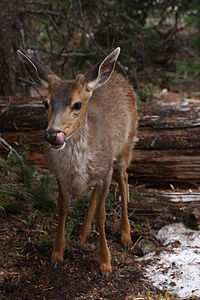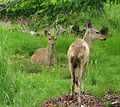- Black-tailed deer
-
Black-tailed deer Male Black-tailed Deer (Olympic National Park) Scientific classification Kingdom: Animalia Phylum: Chordata Class: Mammalia Order: Artiodactyla Suborder: Ruminantia Family: Cervidae Subfamily: Capreolinae Genus: Odocoileus Species: O. hemionus Subspecies: O. h. columbianus Trinomial name Odocoileus hemionus columbianus
(Richardson, 1829)Two forms of black-tailed deer or blacktail deer occupying coastal temperate rainforest on North America's Pacific coast are subspecies of the mule deer. They have sometimes been treated as a species, but virtually all recent authorities maintain they are subspecies.[1][2][3][4][5][6][7] The Columbian black-tailed deer (Odocoileus hemionus columbianus) is found in western North America, from Northern California into the Pacific Northwest and coastal British Columbia.[8] The Sitka black-tailed deer (Odocoileus hemionus sitkensis) is found coastally in British Columbia, Southeast Alaska and Southcentral Alaska (as far as Kodiak Island).[9][8][10][11]
Contents
Range
Black-tailed deer once lived at least as far east as Wyoming. In Francis Parkman's The Oregon Trail, an eyewitness account of his 1846 trek across the early West, while within a two-days ride from Fort Laramie, Parkman writes of shooting what he believes to be an elk, only to discover that he has killed a Black-tailed Deer.[12]
The Black-tailed deer is currently common in northern California, western Oregon, Washington, in coastal and interior British Columbia, and north into the Alaskan panhandle. It is a popular game animal.
Taxonomy
Though it has been argued that the black-tailed deer is a species, virtually all recent authorities maintain it as a subspecies of the mule deer (Odocoileus hemionus).[1][2][3][4][5][6][7] Strictly speaking the black-tailed deer group consists of two subspecies, as it also includes O. h. sitkensis (Sitka black-tailed deer).[2] The black-tailed deer group and the mule deer group (sensu stricto) hybridize, and it appears the mule deer evolved from the black-tailed deer.[6] Despite this, the mtDNA of the white-tailed deer and mule deer is similar, but differs from that of the black-tailed deer.[6] This may be the result of introgression, although hybrids between the mule deer and white-tailed deer are rare in the wild (apparently more common locally in west Texas), and the hybrid survival rate is low even in captivity.[4][6]
Ecology
This species thrives on the edge of the forest, as the dark forest lacks the underbrush and grasslands that the deer prefers as food, and completely open areas lack the hiding spots and the cover it prefers for harsh weather. One of the plants that black-tailed deer browse is western poison oak, despite its allergen content.[13] This deer often is most active at dawn and dusk, and is frequently involved in collisions with automobiles.
Controversy over habitat management
In Southeast Alaska, the Sitka black-tailed deer is the primary prey of Alexander Archipelago wolf (Canis lupus ligoni), which is endemic to the region and rare.[14] In the mid-1990s the United States Fish & Wildlife Service evaluated a petition to list this wolf species as threatened, and decided in August 1997 that a listing was not warranted, largely on the basis of provisions the Forest Service had included to protect the viability of the wolf species in its Forest Plan for the Tongass National Forest, adopted three months earlier.[15] The Tongass NF is important in wolf conservation because it includes about 80% of the region's land area. The protections for the wolf included a standard and guideline intended to retain, in the face of losses logging, enough habitat carrying capacity for deer in winter to assure the viability of the Alexander Archipelago wolf and an adequate supply of deer for hunters. The need carrying capacity was originally specified as 13 deer per square mile, but was corrected in 2000 to 18. Use of a deer model is specified for determining carrying capacity, and is the only tool available for the purpose.[16][17]
However, the Forest Service's implementation of the deer provision in the Tongass wolf standard and guideline has been controversial for many years, and led to a lawsuit by Greenpeace and Cascadia Wildlands in 2008, over four logging projects.[18] Issues raised included these two. It was alleged that the dataset the Forest Service was using in the deer model was known through the agency's own study, done in 2000, to generally overestimate the carrying capacity for deer.[19] The study showed that the data set, called Vol-Strata, is uncorrelated to habitat quality, which generally causes the carrying capacity for deer to be overestimated and logging impacts to be underestimated,[20][21] Also, a conversion factor, known as the "deer multiplier" (used in calculating carrying capacity) was incorrectly applied, causing — by itself – a 30% overestimation of carrying capacity and corresponding underestimation of impacts.[19] The combined effect of the two errors is variable because Vol-Strata is uncorrelated to habitat quality. It is, for the Traitors Cove Timber Sales project the plaintiffs said in 2011 oral arguments before the 9th Circuit Court of Appeals, the difference between a claimed 21 deer per square mile in the project EIS, and 9.5 deer per square mile (about half of the Forest Plan's requirement) according to unpublished corrections made by the agency in 2008.[22]
A ruling was issued in favor of plaintiffs on August 2, 2011 by the 9th Circuit, remanding the four timber sale decisions and giving guidance for what is necessary during renanalysis of impacts to deer.[23] The ruling says in part:
- "We do not think that USFS has adequately explained its decision to approve the four logging projects in the Tongass. ... USFS has failed to explain how it ended up with a table that identifies 100 deer per square mile as a maximum carrying capacity, but allows 130 deer per square mile as a potential carrying capacity. 'The agency is obligated to articulate a rational connection between the facts found and the choices made,' which the agency has not done here. Pac. Coast Fed’n of Fisherman’s Ass’ns v. U.S. Bureau of Reclamation, 426 F.3d 1082, 1091 (9th Cir. 2005)..."[23]
- "We have similar questions about USFS’s use of VolStrata data, which identifies total timber volume and not forest structure, to approve the projects, where forest structure—and not total timber volume—is relevant to the habitability of a piece of land. USFS itself has recognized the limitations in the VolStrata data. ... Because we must remand to the agency to re-examine its Deer Model, we need not decide whether the use of the VolStrata data was arbitrary and capricious. We anticipate that, in reviewing the proposed projects, USFS will use the best available data ..."[23]
In a statement to the press, a spokesman for the plaintiffs said that the errors in this lawsuit apply to every significant Tongass timber sale decision between 1996 and 2008, before the Forest Service corrected errors in the deer model when the agency issued its revised Tongass Forest Plan in 2008. But he said that despite those corrections the agency still fails to address cumulative impacts to deer, especially on Prince of Wales Island, as is being challenged in the Logjam timber sale lawsuit, by ignoring substantial logging on non-federal lands.[24]
Gallery
-
Black-tailed deer in late July near Apiary, Oregon
-
Two juveniles, Salt Spring Island, British Columbia
-
Male black-tailed deer, like this one from Olympic National Park, develop antlers in the summer
References
- ^ a b "Odocoileus hemionus". IUCN Red List of Threatened Species. Version 2010.4. International Union for Conservation of Nature. 2008. http://www.iucnredlist.org/apps/redlist/details/42393. Retrieved 1 March 2011.
- ^ a b c Wilson, Don E.; Reeder, DeeAnn M., eds (2005). Mammal Species of the World (3rd ed.). Baltimore: Johns Hopkins University Press, 2 vols. (2142 pp.). ISBN 978-0-8018-8221-0. OCLC 62265494. http://www.bucknell.edu/msw3/browse.asp?id=14200267.
- ^ a b Novak, R. M. (1999). Walker's Mammals of the World. 6th edition. ISBN 0-8018-5789-9
- ^ a b c Heffelfinger, J. (version 2 March 2011). Tails with a dark side: The truth about whitetail - mule deer hybrids.
- ^ a b Reid, F. A. (2006). Mammals of North America. 4th edition. ISBN 978-0-395-93596-5
- ^ a b c d e Geist, V. (1998). Deer of the world: their evolution, behaviour, and ecology. ISBN 978-0811704960
- ^ a b Feldhamer, G. A., B. C. Thompson, and J. A. Chapman, editors (2003). Wild mammals of North America: biology, management, and conservation. 2nd edition. ISBN 978-0801874161
- ^ a b B.C. Ministry of Env., Lands & Parks. (Undated) Mule and black-tailed deer in British Columbia.
- ^ B.C. Ministry of Forests. 1996-1998. Coastal black-tailed deer study. Webpage linking to the study's five reports. [1]
- ^ MacDonald,S. & Cook,J. 2007. Mammals and Amphibians of Southeast Alaska. [2]
- ^ U.S. Fish & Wildlife Service (2011 - latest webpage update). Kodiak National Wildlife Refuge - Wildlife - Mammals. [3]
- ^ Francis Parkman (1910) The Oregon Trail, Ginn and company, 361 pages
- ^ C.Michael Hogan (2008) Western poison-oak: Toxicodendron diversilobum, GlobalTwitcher, ed. Nicklas Stromberg [4]
- ^ Person, D.K. (Univ. Alaska); Kirchhoff, M. (ADF&G); van Ballenberghe, V. (USFS-FSL); Iverson, G.C. (USFS); Grossman, E. (USF&WS). 1996. "The Alexander Archipelago Wolf: A Conservation Assessment," Gen. Tech. Rep. PNW-GTR-384. Portland, OR: U.S. Department of Agriculture, Forest Service, Pacific Northwest Research Station. [5]
- ^ USF&WS. 1997 (Aug. 28) 12-month finding, re: Petition to List the Alexander Archipelago Wolf under Provisions of the Endangered Species Act.
- ^ 1997 TLMP Wolf standard and guideline: reproduced at Wildlife Habitat Planning: WILD112, XI.A.3 in [6]. The 13 deer per square mile carrying capacity was an error, corrected in 1998 to 17, and in 2002 to 18 deer per square mile.
- ^ Tongass Forest Plan Implementation Clarification, 1998; and directive of Tom Puchlerz, Tongass Forest Supervisor, Aug. 6, 2002. See also: [7]
- ^ Greenpeace v. Cole.
- ^ a b "Suit Filed to Stop Four Timber Sales on Largest National Forest" - Sit News
- ^ Caouette, J.; Kramer, M.; Nowacki, G. 2000. Deconstructing the Tongass Timber Paradigm. USDA Forest Service. [8]
- ^ US Forest Service, 2008 FEIS for Tongass Land Management Plan. p.3-265-266.[9]
- ^ Audio recording of oral arguments before 9th Circ. Ct. of Appeals, May, 3, 2011. Hear: argument by Chris Winter (Crag Law Center) attorney for Greenpeace v. Cole plaintiffs generally, and at 13:20 concerning Traitors Cove. Recording includes arguments by Winters and federal attorney Charles Scott, and Winter's rebuttal.[10]
- ^ a b c Memorandum. Issued unanimously by the 9th Circuit Court of Appeals panel of Judges Alarcon, Graber and Bybee. August 2, 2011. [11]
- ^ Appeals court overturns 4 Tongass logging projects. by Jonathan Grass, Juneau Empire, August 3, 2011. [12]
External links
 Media related to Black-tailed Deer at Wikimedia Commons
Media related to Black-tailed Deer at Wikimedia Commons- Excerpts from the book Black-tailed Deer of California
- Black-tailed Deer at BritishColumbia.com
Categories:- Deer
- Mammals of North America
- Fauna of the California chaparral and woodlands
- Fauna of the Western United States
- Fauna of Canada
Wikimedia Foundation. 2010.





